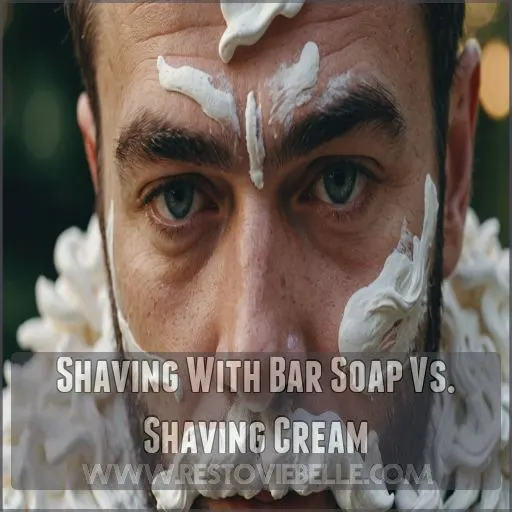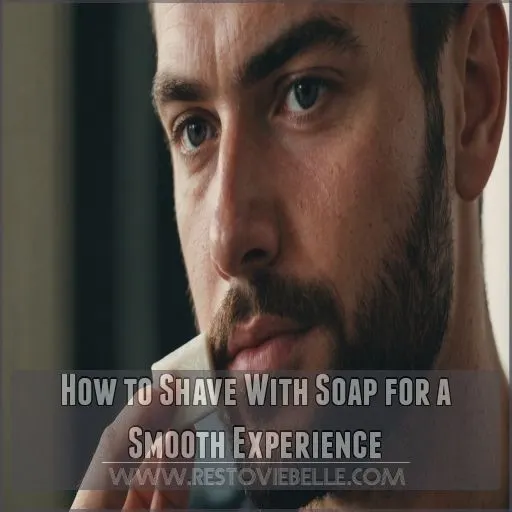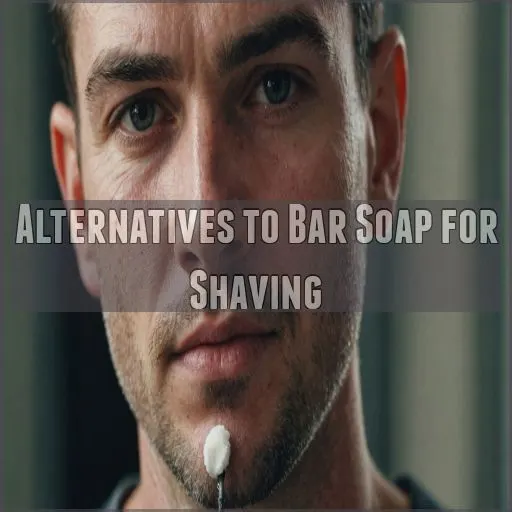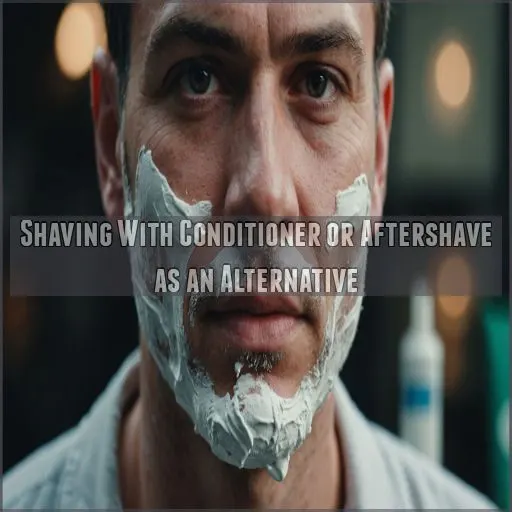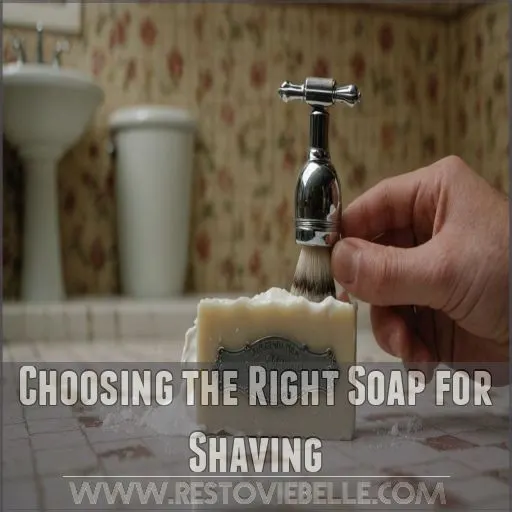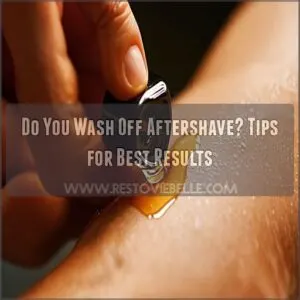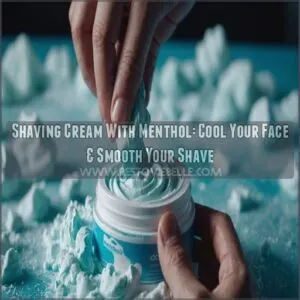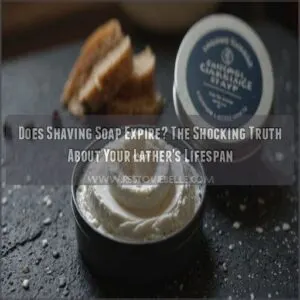This site is supported by our readers. We may earn a commission, at no cost to you, if you purchase through links.
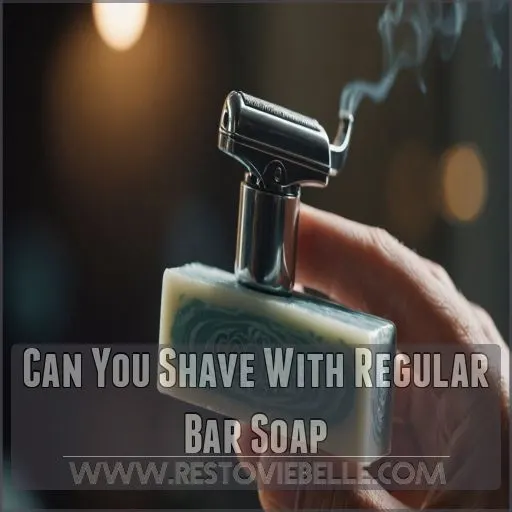 Can you shave with regular bar soap? Sure, but it’s a bit like using a spoon to spread butter—doable but not ideal.
Can you shave with regular bar soap? Sure, but it’s a bit like using a spoon to spread butter—doable but not ideal.
Bar soaps lack the creamy lather that gives razors that smooth glide, which means you’ll face more friction and potential skin irritation.
While it’s a budget-friendly option, bar soap can dry out your skin and dull your razor faster than you might expect.
So, if you’re in a pinch or feeling adventurous, go for it! But if silky skin is your game, you might want to explore other options. Want to learn how to elevate your shaving experience? Keep reading!
Table Of Contents
- Key Takeaways
- Can You Shave With Regular Bar Soap
- What is a Shaving Soap Bar
- Shaving With Bar Soap Vs. Shaving Cream
- How to Shave With Soap for a Smooth Experience
- Alternatives to Bar Soap for Shaving
- Shaving With Conditioner or Aftershave as an Alternative
- Choosing the Right Soap for Shaving
- Frequently Asked Questions (FAQs)
- Can You shave with bar soap?
- What is a shaving soap bar?
- Can you use a soap bar instead of shaving foam?
- How do you shave with soap?
- Can I use a bar of soap instead of shaving cream?
- Can you use bar soap to shave your pubic area?
- What soap should I use to shave?
- Can I shave my hair with soap?
- Does bar soap affect razor blade longevity?
- Can bar soap cause skin irritation when shaving?
- Is there a difference in post-shave feel?
- How do animal fats enhance soap lather?
- Do clay soaps improve shaving experience?
- Conclusion
Key Takeaways
- Shaving with bar soap is doable but not ideal, much like spreading butter with a spoon—expect some friction and potential for razor drag, which might leave your skin feeling as if you just wrestled with sandpaper.
- If you’re pinching pennies or love a challenge, bar soap is a budget-friendly choice that gets the job done. Just don’t forget the extra moisturizer afterward to prevent that dry, tight skin feeling.
- Bar soap might turn your razor into a quick casualty; it can dull blades faster than you can say "smooth shave," so keep those replacements handy if you go this route often.
- For a silky, irritation-free shave that feels more like a spa day and less like a sledgehammer to the skin, consider stepping up to shaving soap or cream—with a lush lather and glide, these are your real knights in shining armor.
Can You Shave With Regular Bar Soap
Shaving with regular bar soap might seem like a quick fix, but it’s not exactly the best choice for your skin.
Before you reach for that soap bar, let’s explore why it might leave your face feeling more like a sandpaper test than a smooth shave.
What to Expect From Shaving With Bar Soap
When you use bar soap for a wet shave, expect a lather that’s often less creamy than shaving soap, potentially hindering razor glide. You might feel like you’re using a sledgehammer to swat flies, battling razor bumps and skin irritation along the way.
But hey, it’s a convenient, budget-friendly option for casual shaves.
- Lather quality can vary
- Potential for razor drag
- Risk of skin irritation
- Convenient for quick shaves
Pros and Cons of Using Bar Soap for Shaving
Shaving with bar soap can feel like turning back the clock to simpler times.
It’s pretty cheap and gets the job done, but you might find the lather a bit lacking compared to dedicated shave soaps.
Soap’s drying nature could leave your skin parched.
For a quick fix, it’s fine; just don’t expect perfection.
Skin Irritation and Razor Burn Risks
You might think grabbing regular bar soap instead of your usual shaving foam is harmless. But there are hidden risks! It can lead to pesky skin irritation or razor burn.
- Sensitive Skin: Bar soap lacks glide, causing friction.
- Razor Blade Choice: Dulls the blade quickly.
- Post-Shave Care: Might need extra moisturizer.
How Bar Soap Compares to Shaving Soap
Imagine lathering up with bar soap and expecting a smooth glide. It can work, but shaving soap is your knight in shiny armor.
Shaving soap offers superior lather quality and avoids that pesky skin irritation. Its ingredients, like coconut oil or cocoa butter, enhance razor glide and your shaving experience.
Bar soap? It’s like bringing a butter knife to a sword fight (Source).
What is a Shaving Soap Bar
Wondering what sets shaving soap apart from your everyday bar soap? Shaving soaps are specially formulated to provide a luxurious lather and superior glide for a smooth, irritation-free shave.
Key Differences Between Shaving Soap and Bar Soap
When you dive into lather quality, you’ll notice shaving soap whips up a rich, thick foam perfect for razor glide, unlike bar soap’s watery bubbles.
It uses natural ingredients that hydrate and protect your skin, steering clear of vitamin C and mineral oil.
So, if you’re after comfort and safety with a dash of luxury, stick to shaving soap.
Ingredients and Composition of Shaving Soap Bars
Shaving soap bars differ from regular soap by using ingredients like stearic acid, glycerin, and coconut oil for lathering.
These create a rich foam that protects your skin. Essential oils add a pleasant scent, while baby oil can extend shelf life.
Can a regular bar soap mimic this luxurious experience? Not quite! Enjoy smoother shaves with specialized formulas.
Benefits of Using a Shaving Soap Bar
A shaving soap bar can transform your shave experience with rich lather quality that lubricates and cushions your skin, making those pesky razor burns a thing of the past.
It’s packed with beneficial ingredients that moisturize and nourish, reducing irritation and leaving your skin as smooth as a baby seal, using a long-lasting formula that lasts longer than conventional creams .
How to Choose the Right Shaving Soap Bar
Wondering how to choose the right shaving soap bar? Start with these essentials:
- Shaving soap types: Choose between hard pucks and creamier croaps depending on your lather preference.
- Lather quality: Opt for soaps that whip up rich, protective foam.
- Ingredients matter: Look for nourishing oils like shea butter.
- Skin type and scent preference: Unscented options suit sensitive skin, especially when combined with sensitive shaving cream
.
Your morning shave will never be the same!
Shaving With Bar Soap Vs. Shaving Cream
Shaving with bar soap is like trying to cook a gourmet meal with just a butter knife—possible, but not ideal.
While bar soap might get the job done in a pinch, shaving cream offers richer lather and smoother glide, making the experience more like a walk in the park than a treacherous hike.
Lather Quality and Razor Glide
Imagine you’re preparing for a shave, debating bar soap and shaving cream with the best scents
. Regular soap might seem enough, but shaving cream wins in lather density and slickness, reducing razor drag. Ever felt like shaving with a dull butter knife? Foam stability and glide impact truly matter.
| Aspect | Bar Soap | Shaving Cream |
|---|---|---|
| Lather Density | Low | High |
| Slickness Comparison | Moderate | Superior |
| Razor Drag | High | Low |
| Foam Stability | Unstable | Stable |
Ultimately, for fewer nicks, invest in shaving cream!
Skin Moisturization and Protection
For skin moisturization and protection, regular bar soap simply can’t compete with shaving creams and soaps.
Shaving creams are formulated with nourishing ingredients like:
- Glycerin to hydrate and soothe
- Aloe vera to calm irritation
- Vitamin E to nourish
Shaving soaps also create a richer, more lubricating lather that helps your razor glide effortlessly across your skin.
Convenience and Ease of Use
Balancing skin moisturization with convenience often leads many to choose between shaving soap and regular bar soap.
Shaving soap and regular bar soap have different characteristics when it comes to ease of use and overall experience. Shaving soap offers ease, needing fewer steps compared to the bar soap’s lathering ritual.
| Factor | Shaving Cream | Bar Soap |
|---|---|---|
| Ease of Use | High | Moderate |
| Lather Quality | Creamy | Varied |
| Travel Convenience | Excellent | Depends |
| Razor Glide | Smooth | Depends |
Shaving Results and Overall Experience
Shaving with bar soap can feel like steering a canoe with a teaspoon—awkward but surprisingly effective if you’re in a pinch.
The soap lather is thin, often disappearing faster than a magician’s rabbit.
You might experience razor burn or skin sensitivity when using a sensitive skin razor
.
It’s not ideal for shave prep, but it’ll work in a bind, an option when you’re in a pinch.
How to Shave With Soap for a Smooth Experience
Shaving with regular bar soap mightn’t sound glamorous, but it can offer a decent shave if you’re in a pinch.
Just be ready to work up a good lather, and don’t blame the soap if you miss a few spots—bar soap wasn’t exactly designed for this job, so it’s not ideal for a good lather.
Preparing Your Skin for Shaving
A smooth shave’s all about prep, right? Splash your face with warm water to open pores and soften hair, making shaving less like tug-of-war. Pre-shave exfoliation clears dead skin, staving off those pesky razor bumps. If you’re feeling fancy, a little shaving oil can be used for smooth sailing.
Your skin’s sensitivity deserves the royal treatment!
- Open pores with warm water
- Exfoliate for smoother results
- Use shaving oil for glide
- Mind your skin’s sensitivity
- Keep razor bumps at bay
Creating a Rich Lather With Bar Soap
You’ve prepped your skin, so let’s lather up with bar soap!
Choose a soap puck wisely—Ivory or Dove+ Men can create a satisfying lather.
Use a soap brush and warm water; don’t rush it. Aim for a creamy texture.
| Soap | Lather Time | Texture | Satisfaction Level |
|---|---|---|---|
| Ivory | 20 sec | Creamy | |
| Dove+ | 25 sec | Smooth |
Happy shaving!
Shaving Techniques for a Smooth Experience
Start with a solid pre-shave routine; soften those whiskers with warm water.
Rub the soap bar directly onto your face, then work up a rich lather with a brush if you’ve got one.
Always shave with the grain to dodge razor burn.
If the soap dries, add water. It’s like doing a facial obstacle course gracefully—complete with soap suds!
Post-Shave Care and Moisturization
After a close shave, your skin deserves some TLC.
Rinse with cold water to soothe irritation, then pat dry gently.
Next, apply a nourishing aftershave balm or moisturizer to rehydrate and protect your skin.
Look for natural ingredients like aloe vera or shea butter to keep your complexion smooth and healthy.
Alternatives to Bar Soap for Shaving
If you’re tired of wrestling with bar soap for shaving,’ve got some alternatives that might just make your skin (and razor) happy.
Let’s explore easier and smoother options like shaving gels, coconut oil, or even trusty old conditioner.
So you can ditch the soap struggle for good!
Shaving Creams and Gels
Choosing the right shaving cream or gel can feel like choosing between donuts and pastries—both are tempting.
With these, enjoy:
- Lather Quality: Creams offer smoother glide; gels can be quicker.
- Scent Options: Citrus to musk, pick your vibe.
- Skin Types: Sensitive? Go for natural ingredients.
Check out user reviews and compare brands for the perfect fit.
Aftershave and Conditioner for Shaving
Thinking about shaving with conditioner instead of the usual?
It’s a nifty trick! Conditioner softens hair and offers a smooth glide, perfect for shaving sensitive skin
.
Plus, it’s great if you’re out of aftershave or need a DIY solution.
Just slather it on like you own the place—your skin will thank you for the extra pampering boost!
Coconut Oil and Other Natural Oils
Why not give coconut oil a whirl for shaving?
It hydrates and protects, making it great for sensitive skin.
But beware: coconut oil can get slippery and mightn’t be as slick as shaving cream.
Try a DIY oil blend by adding other oils for glide.
Remember, oil won’t foam, but it’ll leave your skin soft!
Shaving Soap Bars and Croaps
When you’re choosing between shaving soap bars and croaps, it’s like picking between apples and slightly squishier apples.
- Easier to lather, with texture like soft cheese.
- Eco-friendly options abound.
- Shaving soap benefits include better glide and hydration.
- Try DIY soap recipes for customization.
Curious what’s best? Check out artisan brands!
Shaving With Conditioner or Aftershave as an Alternative
Shaving with conditioner can be your secret weapon when you’re in a pinch and out of shaving cream.
While it might sound unconventional, both can offer unexpected smoothness and comfort.
Leaving you feeling like you just discovered a hidden hair-removal hack.
Pros and Cons of Using Conditioner for Shaving
Conditioner can be a surprisingly effective shaving lubricant, leaving your skin silky smooth. However, it may not provide the same cushioning and protection as dedicated shaving products.
Consider the trade-offs:
| Pros | Cons |
|---|---|
| Moisturizing | Less effective lather |
| Smooth glide | Potential for irritation |
| Affordable | May clog razors |
| Convenient | Doesn’t provide as much lubrication |
Ultimately, it’s worth experimenting to see if conditioner works for your shaving routine.
Pros and Cons of Using Aftershave for Shaving
Using aftershave for shaving? It’s a bit like using a band-aid before you’ve cut yourself.
Aftershave can protect and soothe, reducing irritation and preventing breakouts with ingredients like aloe vera and witch hazel .
However, alcohol-based options might dry your skin and sting more than you’d like.
Consider aftershave alternatives like oils for a smoother ride.
How to Use Conditioner or Aftershave for Shaving
Shift your shaving routine with conditioner or aftershave.
Conditioner offers smooth razor glide and skin hydration, acting as a two-in-one shaving cream substitute. Aftershave adds an element of chill, soothing shaving irritation relief post-shave skin while also preventing irritations
.
Apply either like you’d shaving cream, ensuring even coverage. Just remember—razor in hand, you’re the boss here! .
Skin Benefits and Drawbacks
Imagine shaving with conditioner or aftershave instead of typical shaving cream. These products aren’t just for your post-shave pamper.
They can soften your hair, making shaving smoother.
But watch out! They’re not designed for shaving, so skin irritation or razor burn might sneak up on you.
Have dry or sensitive skin? Consider this a gentle warning sign.
Choosing the Right Soap for Shaving
If you’re unsure about which soap to lather up with before shaving, knowing what to look for can be a game-changer.
Grab some shaving soap that’s got moisturizing ingredients, and your skin will thank you later.
No one wants to battle razor burn over breakfast!
Key Ingredients to Look for in Shaving Soap
You’ve got options.
Shaving soaps boast stearic acid for creamy lather, glycerin for slickness, and coconut oil for stability .
Essential oils can add fragrance and antiseptic qualities .
So, before shaving with conditioner or aftershave, check for these ingredients to make sure you get a rich, protective lather that leaves you as smooth as a well-buttered biscuit.
How to Read Soap Labels and Ingredients
Understanding soap labels is like deciphering a secret code.
You’ll want to seek natural ingredients, spot those sneaky sulfates, and avoid overpowering fragrances.
Essential oils add a nice touch, but watch for skin sensitivities.
Remember, you’re in control of your shave journey—knowing your labels is key to avoiding unexpected surprises. It’s also about avoiding those overpowering fragrances and knowing you are in control of your journey and that makes it this enlightening.
Who knew shaving could be this enlightening?
Natural and Organic Soap Options
For a natural and organic shaving experience, seek out handcrafted soaps infused with nourishing ingredients like olive oil, shea butter, and avocado.
These artisanal soaps provide a rich, creamy lather but also help protect and moisturize your skin during the shave.
Explore local makers or eco-friendly online shops for the best organic shaving options.
Fragrance-Free and Hypoallergenic Soap Options
Seeking a smooth shave without smelling like a floral shop?
Fragrance-free and hypoallergenic soaps are your best bets, especially for sensitive skin.
Choose options with natural ingredients like calendula or aloe, which soothe skin while preventing soap allergies. Unscented soaps, such as Mystic Water Soap or Sego Unscented, are excellent choices for a silky-smooth finish.
Frequently Asked Questions (FAQs)
Can You shave with bar soap?
When push comes to shove, you can shave with bar soap, but it’s like using a Swiss Army knife instead of a chef’s knife.
You’ll get by, but opt for moisturizing or glycerin-based soap for better results.
What is a shaving soap bar?
A shaving soap bar is specially formulated to create a rich, protective lather that helps your razor glide smoothly.
It contains ingredients for increased moisturization and skin protection, unlike regular soaps . Also, it helps in minimizing nicks and irritation.
Can you use a soap bar instead of shaving foam?
You can use a soap bar instead of shaving foam, but it’s not ideal.
Soap can clog razors and blunt the blade, making shaving tougher.
If you’re stuck, go slow and rinse often to avoid cuts.
How do you shave with soap?
A smooth shave starts with the right soap.
While regular bar soap can work in a pinch, shaving soaps are specially formulated to provide superior lubrication and lather for a closer, more comfortable shave.
Can I use a bar of soap instead of shaving cream?
Skipping shaving cream for bar soap is not ideal.
Soap dries your skin and clogs the razor, causing nicks or irritation.
If you’re in a pinch, lather well and shave gently, but expect less comfort (Source).
Can you use bar soap to shave your pubic area?
Imagine this: it’s 1880, and bar soap is all you have.
Though it might work in a pinch, bar soap isn’t the best choice for shaving your shaving essentials due to potential irritation and blunt razor blades
.
What soap should I use to shave?
For a smooth shave, try Stirling, RazoRock, or Proraso soaps.
They’re budget-friendly and provide a slick, creamy lather that’s great for your skin.
Plus, experimenting with samples lets you find that perfect match (Source).
Can I shave my hair with soap?
You can shave with regular bar soap, but don’t expect the smoothest glide.
It mightn’t lather as well as a shaving soap and can be drying, so use plenty of water for the best results.
Does bar soap affect razor blade longevity?
Using bar soap can shorten razor blade life.
It tends to leave more residue, making the blade dull faster and affect its smooth gliding .
Keep your blades sharper longer by opting for dedicated shaving products.
Can bar soap cause skin irritation when shaving?
Bar soap can sometimes spark skin irritation while shaving.
Sudsy chunks mightn’t provide proficient protection.
Plump for a moisturizing or glycerin-rich; these often offer smoother slides and safeguard against nicks and nasty razor burns.
Is there a difference in post-shave feel?
Shaving with regular bar soap can leave your skin feeling dry and irritated compared to using a dedicated shaving soap.
Shaving soaps are formulated to provide a slick, moisturizing lather for a more comfortable post-shave feel.
How do animal fats enhance soap lather?
Animal fats like lard and tallow give soap a creamy, stable lather you’ll love.
They create hard, enduring bars that don’t melt away quickly, saving you from the dreaded soap goo dance in the shower.
Do clay soaps improve shaving experience?
Clay soaps can enhance your shave by adding slickness and protective cushion.
They can also prevent nicks and cuts.
However, personal preference matters, as some find them drying or mildly abrasive, while others love the slickness they provide.
Conclusion
Just as Sherlock Holmes might deduce, you can shave with regular bar soap, but better results often lie elsewhere.
While bar soap gets the job done in a pinch, consistent smoothness and skin comfort benefit from alternatives. Consider the risks of irritation and lack of moisture your skin might face.
For good results, explore shaving soaps, creams, and even conditioners. Check out a well-tailored approach, and let your razor glide like Watson anticipating Holmes’ next move.


